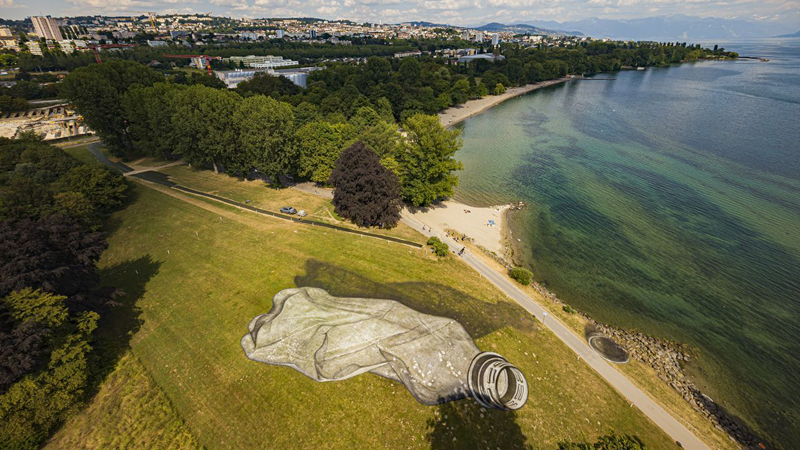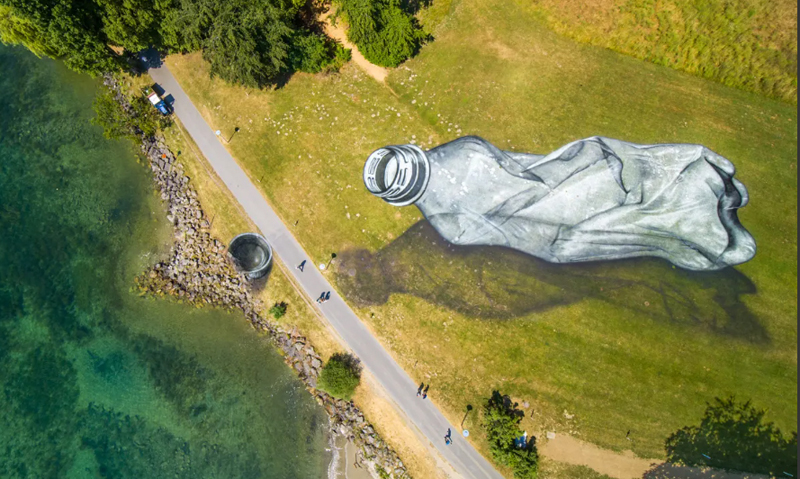The city of Lausanne in Switzerland is renowned for its natural beauty, rich culture and continued support for public art. Recently, the city witnessed an intriguing work of art by contemporary artist Saype. A giant bottle has been placed on the shores of Lake Geneva, creating a visually striking and thought-provoking installation for locals and visitors. In this article, we will explore this work of art in detail and analyze its profound message. Saype created a new fresco for his project “Trash” in the Bourget de Lausanne park. In this series, the artist based in Moutier paints gigantic wastes that he considers to be “future vestiges of our mode of consumption and our current relationship with nature”.
“Ephemeral, my waste will not leave traces”, recalls the artist about his works. Saype alias Guillaume Legros, uses a biodegradable paint composed mainly of chalk and charcoal. The former nurse seeks to capture “the fragility of our societies and the challenges that we are all called upon to take up”. His ephemeral works aim to “impact mentalities while respecting nature”.
Art at the service of the environment:
Saype, whose real name is Guillaume Legros, is known for his monumental and ephemeral art in which he uses biodegradable paints made from milk and vegetable charcoal. Its objective is to establish a link between art and nature while raising public awareness of current environmental issues. The installation of the giant bottle in Lausanne perfectly illustrates this artistic vision.
The symbolism of the bottle:
The giant bottle placed on the shores of Lake Geneva has a deep meaning. It represents the fragile balance of the marine ecosystem and refers to the plastic pollution that threatens our oceans. Saype has used his art to draw attention to this pressing issue, prompting viewers to reflect on the impact of our actions on nature.

The installation of the work:
Installing the cylinder was a complex undertaking that required a team of several people and the use of specialist techniques. The bottle, measuring several tens of meters in length, was painted with Saype’s characteristic biodegradable materials. Saype’s artistic method involves projecting an image onto the ground and then reproducing it life-size. The result is a work of art that seems to fit harmoniously into its surroundings.
Audience reactions:
Since the installation of the giant bottle, the reactions of the public have been diverse. Some were fascinated by the size and beauty of the work, while others were deeply moved by its environmental message. Many have shared photos on social media, helping to raise awareness about plastic pollution to an even wider audience.
Impact on the community:
Saype’s work has had a significant impact on the community of Lausanne and beyond. It sparked discussions on contemporary art and the importance of preserving our environment. In addition, the bottle installation has attracted visitors and boosted tourism in the region. This combination of art and environmental awareness has created a positive and lasting effect on the city.
Conclusion :
Lausanne has once again demonstrated its commitment to public art and the environment with the installation of the giant Saype bottle on the shores of Lake Geneva. This monumental work of art highlights the importance of preserving our oceans and reducing plastic pollution. It reminds each of us of the responsibility we have as individuals to protect our planet. Art can be a powerful force for change, and Saype’s work is a shining example. Hopefully this installation will inspire other artists and communities to use their creativity to raise awareness and preserve our precious environment.








